“The CASTOR consignments stand for everything I hate about this country and this system: police protecting big-corporate interests, democracy ignored, parties that only lie, media that only propagandise instead of reporting independently, inhumane technology, lobby-driven policies.”
The words of one of 50,000 protesters who over the weekend went to the tiny village of Gorleben in central-north Germany, which normally is home to 600 people, to oppose the 12th delivery of nuclear waste containing the radiation equivalent of about 100 Hiroshima bombs.
The train and trucks brought 11 caskets for the transportation and storage of nuclear waste, CASTOR for short, from Normandy, France, where it was recycled in a plutonium factory (follow the run on an updating map at http://castorticker.de/map).
It was the longest such 1,000-km trip ever: three days, 19 hours, 24 minutes, a day and a half longer than it’s meant to be, the delay caused by protest actions in both countries. For a diary of the entire journey go to http://de.indymedia.org/2010/11/294032.shtml.
Opponents are celebrating that as a success they hope will be a wake-up call to the conservative-led government to immediately take back the 12 years longer running times it’s legislated for the 17 stations of the four nuclear power companies and ultimately to outlaw nuclear power production.
Protesters, who include political parties, churches and trade unions, know they can’t stop the CASTOR deliveries but to drive home their point they make them as expensive as possible financially, politically and medially. This year’s is being costed at 50 million euros (69 million Australian dollars), the most expensive policing ever.
The waste train ran past and in some cases through some of the most densely populated cities in France and Germany.
 width="250" align="right" alt="police action on track.jpg">It’s one of the givens of the Wendland protests that the outcome is known from the outset. There’s no return ticket for the CASTORS; no matter what it costs, they have to get into that prefabricated, air-cooled hall locals deride as a potato barn.
width="250" align="right" alt="police action on track.jpg">It’s one of the givens of the Wendland protests that the outcome is known from the outset. There’s no return ticket for the CASTORS; no matter what it costs, they have to get into that prefabricated, air-cooled hall locals deride as a potato barn.
So far the score has always been against the activists. But they’re still the winners.  width="250" align="right" alt="woman lying.jpg">
width="250" align="right" alt="woman lying.jpg">
The demonstrators
The 50,000 who went to Gorleben were two and a half times as many as the 20,000 originally expected and planned for. At least 400 coaches were counted.
For four days the transport from Valognes to Gorleben was harassed by a broad variety of protest actions and tenacious resistance. There were five successful  width="250" align="right" alt="Bullenaktion_20101108-18.jpg">chain-ons, three huge squat blockades and countless demonstrations, vigils, acts of sabotage, blockades by hundreds of farm tractors, digging a ditch across a road, lantern processions and climbing/abseiling actions.
width="250" align="right" alt="Bullenaktion_20101108-18.jpg">chain-ons, three huge squat blockades and countless demonstrations, vigils, acts of sabotage, blockades by hundreds of farm tractors, digging a ditch across a road, lantern processions and climbing/abseiling actions.
Despite massive police violence, thousands of women and men managed to remove ballast stones along about 500 metres of railway track. When the stone removers withdrew late Sunday afternoon, there were quite a few holes under the rails, rated as a successful day. It won’t have done much damage. A repair train was seen running, which meant that either nothing needed to be repaired or it was quickly  width="250" align="left" alt="castor infrared.jpg">done. Removing stones had been hyped as the main hands-on activities. For several hours 5,000 people blockaded several kilometres of track. Despite the police excesses, people kept going back to the rails for brief periods to remove ballast before they were beaten back. Although activists were injured, they returned to the camps content and feeling they’d had a win.
width="250" align="left" alt="castor infrared.jpg">done. Removing stones had been hyped as the main hands-on activities. For several hours 5,000 people blockaded several kilometres of track. Despite the police excesses, people kept going back to the rails for brief periods to remove ballast before they were beaten back. Although activists were injured, they returned to the camps content and feeling they’d had a win.
The stone removal tied up many police, opening space for rail squatters; later many stone removers joined the squatters. The one flowed into the other. Solidarity from all sides: food, blankets, bags full of warm clothes, home-made stuff, leftovers from granddad’s 70th birthday – it was all gratefully received while at the same time the farmers for several hours effectively closed the roads to police supplies and reinforcements.
An appeal to local residents for more support for the people’s kitchens resulted in an incredible wave of donations, especially to supply people squatting on the tracks and roads.
Activists hacked and defaced the propaganda page of the nuclear mafia, http://www.kernenergie.de. A Greenpeace paraglider carrying a "Stop Castor" banner took a geostationary position above the truck convoy, a police helicopter in pursuit. 1,200 sheep and 500 goats had to be removed from the CASTOR route.
An inspired Greenpeace action had police bamboozled for 12 hours. An innocuous-looking apparent drinks delivery truck stopped at the entrance to the train-to-truck reloading compound in Dannenberg. Inside, a reinforced steel container containing activists was lowered to the ground and fixed there with fast-setting cement. For a long time police just didn’t know how to deal with it.
There was also the old favourite of four farmers chaining themselves to 1.5-metre-high reinforced concrete pyramids plonked at strategic road junctions. This time police just lifted the lot, pyramid-with-man-attached and moved it aside. But it all added time to the run.
Farmers who know their area like the backs of their hands so effectively blocked roads with their 600 tractors that the police logistics system collapsed. Often food supplies, water cannons, reinforcements had to turn back and try other routes. As a result, some police were said to have been on duty and without food for up to 20 hours. width="250" align="right" alt="grossdemo_20101106-22.jpg">
width="250" align="right" alt="grossdemo_20101106-22.jpg">
On Friday, Day One, there were 21 rallies and vigils along the French CASTOR route. All 5 people who caused the first stop by chaining themselves to the track at Caen an hour and a half into the journey needed hospital treatment, including an  width="250" align="right" alt="fuldatalbruecke.jpg">operation for a severed hand sinew and burns from being cut free. Altogether six activists were presented to an arresting judge after 24 hours in investigative detention. They will be tried on 8 December and face 15,000 euro fines each for interfering with railway operation. An appeal has gone out to help with the costs. The highly nuclearised Grande Nation is tougher than Germany on anti-nuclear protesters.
width="250" align="right" alt="fuldatalbruecke.jpg">operation for a severed hand sinew and burns from being cut free. Altogether six activists were presented to an arresting judge after 24 hours in investigative detention. They will be tried on 8 December and face 15,000 euro fines each for interfering with railway operation. An appeal has gone out to help with the costs. The highly nuclearised Grande Nation is tougher than Germany on anti-nuclear protesters.
 width="250" align="left" alt="klein gusborn.jpg">The floorleader of the opposition Greens in the federal parliament, Renate Künast, lauded the CASTOR protests as “a glorious event for democracy”.
width="250" align="left" alt="klein gusborn.jpg">The floorleader of the opposition Greens in the federal parliament, Renate Künast, lauded the CASTOR protests as “a glorious event for democracy”.
There were manifestations of solidarity with the protests in Wendland across France and Germany.
The police
Almost 20,000 of them, double the size of the Queensland force, the biggest police deployment in post-war Germany. One officer for 2½ protesters (50,000). The force started at 16,500, then all reserves throughout Germany had to be mobilised as reinforcements. Trying to gloss over their waning strength and miserable supply situation, cops escalated and were accused of raw violence by the protesters. As on  width="250" align="right" alt="French policeman.jpg">past CASTOR occasions they used excessive force, injuring more than 1,000 people, 950 of them on their eyes by teargas and pepper spray. At least 16 activists suffered broken bones, 29 head wounds and three concussion. Many needed hospital treatment, some were still in on Monday. Cases were reported of police preventing activist medics from treating the injured. They are accused of having prevented a woman with a thigh fracture being stretchered out. They bashed with truncheons even clearly marked medics obviously attending to the injured. Police used pepper spray to bring down two abseilers from trees and bashed them with truncheons when they were already on the ground. Observers say the pepper spray caused the climbers to fall from the trees from a great height. One suffered a fractured back and other injuries and had to be helicoptered to a clinic. Police pepper-sprayed and bashed people even after the CASTORS had passed. They totally smashed one person’s shoulder. A young woman was injured by being kicked by a police horse.
width="250" align="right" alt="French policeman.jpg">past CASTOR occasions they used excessive force, injuring more than 1,000 people, 950 of them on their eyes by teargas and pepper spray. At least 16 activists suffered broken bones, 29 head wounds and three concussion. Many needed hospital treatment, some were still in on Monday. Cases were reported of police preventing activist medics from treating the injured. They are accused of having prevented a woman with a thigh fracture being stretchered out. They bashed with truncheons even clearly marked medics obviously attending to the injured. Police used pepper spray to bring down two abseilers from trees and bashed them with truncheons when they were already on the ground. Observers say the pepper spray caused the climbers to fall from the trees from a great height. One suffered a fractured back and other injuries and had to be helicoptered to a clinic. Police pepper-sprayed and bashed people even after the CASTORS had passed. They totally smashed one person’s shoulder. A young woman was injured by being kicked by a police horse.  width="250" align="right" alt="loch_in_strasse_20101106-22.jpg">
width="250" align="right" alt="loch_in_strasse_20101106-22.jpg">
When the first groups began to dig stones out of the railway bed they were ruthlessly attacked by police with pepper spray, tear gas, truncheons, horses, dogs and water cannons. False claims by police that they were attacked, for example by gas, are disproved by many videos on the Internet, e.g. Spiegel Online and Graswurzel TV: http://www.youtube.com/watch?v=8Q7dPWhA9D4 A spokesman for the stone removing group said it had been clear police strategy to hurt those activists.
One and a half thousand people taken prisoner from blockades, including elderly and minors, were corralled in below-freezing temperatures and kept standing for hours and without food, warm drinks or blankets in an open air police vehicle encirclement until the CASTORS passed. Exhausted people suffered hypothermia and the usual injuries from needlessly rough police grips. At one point the prisoners were given cushions to sit on and blankets and were brought food by Wendlanders. Several attorneys doubt the legality of this police action. Several people intend to sue. Gorlebeners usually win their cases but usually years after the events, which police seem not to be afraid to repeat because none are ever punished. In the early hours several spontaneous demonstrations formed in the “camp” (Lager, the word used by the police, which has an ominous ring in German) and at 10 am all were let go.
With increasing exhaustion, the police became increasingly ruthless, injuring people they dragged out of squat blockades. The local organisers spoke of “a veritable hunt on demonstrators”. Videos taken by demonstrators show a policeman repeatedly punching a defenceless person lying on the ground in the face. Or how a police medic bashed people randomly with his first aid bag. It must not be forgotten that since protests began in Wendland more than 30 years ago, police have always been violent.
A “Committee for Basic Rights and Democracy”, which had 20 observers on location, accuses the police of total failure. “Not even the simplest demands of a law-abiding dispersal of an assembly were obeyed. Demonstrators were not ordered to stand, the assembly was not dispersed, use of force was not announced. Water cannons and horses kept being used against the demonstrators. Those who didn’t obey or didn’t fit police concepts risked being maltreated with rabid violence. Residents were not allowed to leave their houses.”
Police placed an entire village under illegal curfew. Special squads, their faces hooded, stormed and searched four farm homesteads and barns in three villages without warrants. Lawyers happened to be on hand in one case. They say they were given no reason nor would the police identify themselves, just pushing the lawyers away. It was later explained that the raiders were looking for items that could have caused danger. “Searching private homes, which was obviously planned long ago, without a judge’s approval is a scandal,” the lawyers said. “The illegal search is just another link in a long chain of breaches of the constitution by the police during CASTOR consignments.”
Police admitted to using small remote-controlled, quiet and unmanned propeller-driven surveillance drones with cameras, instead of helicopters to watch the protesters.
Police broke many agreements reached with protest organisers, for example not allowing the People’s Kitchen through to prisoners it was trying to supply, doing traffic control, ID checks, people- and vehicle searches. They tried at first to stop Greenpeace taking measurements of radiation coming from the CASTOR trucks close to the home of people who had asked for them. They had to yield on orders from the interior ministry.
The resistance is stunned by the discovery that French CRS riot police, clearly identifiable by their insignia, uniform and armament, took part in the fray. A Berlin lawyer has filed a criminal complaint for pretending to be a German official and illegal possession of arms. The lawyer also reported seeing police with the word “Policija” across their backs. Someone else reported definitely identifying Polish police and there are some suggestions also of Croatians.
The Lower Saxony interior minister Uwe Schünemann said demonstrators injured 78 police personnel, while 53 others hurt themselves through their own fault. Overall, the consignment had been successful he said and “all in all the mood was peaceful”. Makes you wonder what planet he lives on.
A policeman shot himself dead with his service pistol in his accommodation. The spokesman for the Gorleben resistance expressed shock and condolences to the family, as well as the hope that the suicide was not connected in any way with the CASTOR assignment.
The politics
With this consignment costed at about 50 million euros (69 million Australian dollars), debate has resumed, as it does invariably after every shipment, on who should pay. The federal environment and nuclear safety minister, Norbert Röttgen, does not want it to be the four power companies that produced the waste, but the government – in other words, the taxpayers, two thirds of whom want nuclear power thrown out. Nuclear opponents demand that the power companies foot the bill. The police union and taxpayer association have demanded a 50 million euro security fee from the nuclear companies for the transportation. The state government of Lower Saxony, where Gorleben lies, is not prepared to pay it all alone and is getting backing for this stance. But the chairmen of the home affairs committee in the federal parliament rejects any federal share. “Lower Saxony carries a special financial burden,” argues Wolfgang Bosbach, “but so do others.” Other states had already contributed by sending their police, he added. Not all burdens could be offloaded on the federal government “because we’d then always get the argument ‘it’s actually up to the federation to pay because the federation is the cause’.”
Just hours after the 12th consignment was delivered to the interim storage hall in Gorleben, bringing the number of CASTORS now stored there to 102, the responsible Lower Saxony state government ordered the immediate continuation of the operating plans for the specially dug salt mine that is to become the final repository and is within sight of the hall. Opponents say every CASTOR delivered makes it more likely that the waste will stay in Gorleben permanently, even though the salt deposit contains gas and leaks brine.
Germany and Russia are ready to sign an agreement on the shipment from Ahaus in western Germany to Russia of three CASTOR consignments, probably still this year. This is waste from former communist East Germany which used Russian nuclear technology. They would be trucked to Bremerhaven and shipped from there to Murmansk. From there they would move to a plutonium factory in Majak, in one of the radioactively most contaminated parts of the world. The state government of North-Rhine Westphalia, comprising Social Democrats and Greens (!!!) has the power to stop this but is not expected to. The mayor of Bremen has vowed to try to stop the waste moving through his port.
Anyone who extends the operating lives of the nuclear power stations has to expect CASTOR consignments to also take longer, said the spokesman of Bürgerinitiative Umweltschutz Lüchow-Dannenberg (BI), the umbrella group of the Gorleben resistance. The large number who came to the rally, like a people-chain in April and a demonstration by 100,000 in Berlin, reflected that Germans reject the energy policy of the government, said Wolfgang Ehmke in a release. On Saturday 23 October Germans protested against transportation of highly radioactive waste at 120 different locations across the country, organisers claiming a turnout of 10,000 to 20,000 people. The protests were along three railway routes where CASTOR containers are to run within weeks.
Another CASTOR consignment is due to run still this year from a nuclear energy research centre at Cadarache in France to Lubmin in northeast Germany.
The GdP police union criticised the federal government’s nuclear policy. Their president, Konrad Freiberg, called it a political odyssey. “It was a political mistake to undo the strenuously achieved consensus (to drop atomic power by 2020),” he said. This had heated up the Gorleben protests and made the huge police deployment necessary. A deployment of that size must not recur, he added. The president of another police union, Rainer Wendt of the DPolG, wants discussion of whether it’s still democratic protest to block policy supply lines. He said he didn’t know what it had to do with democratic protest that police got nothing to eat. “This job really exploded all dimensions,” Wendt said.
From a commentary on ZEIT ONLINE, the online service of the respected weekly newspaper, Die Zeit (http://www.zeit.de/politik/deutschland/2010-11/castor-proteste-motivation): It’s highly unlikely that the protests will move the government to drop its nuclear policy. And Gorleben will continue to be used as an ‘interim‘ dump where CASTORS are to cool down from 400 degrees centigrade to 200 degrees in 40 years.
That’s not the issue. Much more important is what happened in the squat blockades on these recent days. Population groups sat there bum to bum linked by nothing but the nuclear issue. City children linked arms with Lüneburg housewives to resist the police dispersal squads. In the people’s kitchens old-left perma-protesters washed the dishes of conservative married couples. Farmers of the region put at risk their farm incomes and the integrity of their equipment by over and over again blockading strategically important roundabouts and crossings with their tractors. It’s this kind of solidarity that keeps motivating the anti-nuclear movement.
The Wendland rituals with the predictably certain outcome form the nucleus of a societal movement that stands for much in Germany. At the latest with the first CASTOR shipment to this sparsely populated part of Germany in 1995, the farmers got to know the leftwing movement’s protest culture – plenum meetings and vegan cuisine included. The long nights in the Wendland are not only of emotional value, they also firm and promote the networking of the movement, from high federal politics to local church groups, from the farmer’s emergency coalition to the highly professional Greenpeace PR machine. From the neighbours of the trouble-prone Krümmel nuclear power station to the Stuttgart railway station resistance. Farmers will sit on their tractors and put up with a few days of driving to demonstrate in Berlin. Large demos, with more than 50,000 participating, like those in the capital in September, would hardly be thinkable without the link-piece Gorleben. It was the assumed folklore in Wendland that carried the protest against nuclear energy into the centre of society.
The lawyers
A human-rights-oriented organisation of lawyers, the Republican Association of Attorneys (RAV), demands consequences from what it calls “systematic breakings of the law by police” during the CASTOR transportation.
The RAV wrote in a media release that they observed systematic violations of the right of freedom of assembly and corporal inviolability of the demonstrators and of other fundamental rights. "The often cited overload of individual officers will not do as a reason,” summarised attorney Martin Lemke, the vice president of the RAV.
The criticisms in detail:
Disproportionate use of force
On a scale not experienced in a long time, police without warning and in a disproportionate manner used means of coercion such as teargas and truncheons in a wide area. Members of the legal team, of the committee for basic rights and democracy and members of the federal parliament observed how from a distance of less than 50 cm gas was sprayed directly into eyes. Entire sections of forest were fogged with CS gas so that everyone present there was affected without differentiation. Police officers, including at least in one case a police medic, were seen bashing into demonstrators without warning and visible reason. These actions injured more than 1,000 people. More than 30 demonstrators suffered head injuries, some serious.
Grave injuries after CS gas attack
On Tuesday, 9 November, a professional climber who had chained himself to a tree was attacked without warning with CS gas by a police officer so that he fell down four metres. He suffered a fracture in the chest vertebrae and had to be choppered to hospital. Before that could happen, other police, threatening violence, drove him another 500 metres away although his grave injury was plain to see and witnesses pointed it out to the police.
Impermissible deployment of European police officers
Observers of the legal team several times saw the deployment of armed police officers from France and the presence of other officers from EU states in their respective national uniforms. No adequate legal basis for this has yet been cited by the state of Lower Saxony nor the federal government. Photographers documented the violent attack of a French policeman on a protester. The RAV wants immediate clarification of this case, with possible criminal prosecution.
Police encirclement without legal protection
During the dispersal of the squat blockade in Harlingen on 8 November 2010 led by a Hamburg police leader, police set up an encirclement lasting more than six hours, which was falsely and trivialisingly declared an “open air prisoner collecting point". By ignoring the constitutionally provided judge’s discretion in deprivation of freedom, none of the people held there were presented to a judge at Dannenberg court, so that in this way legal protection was refused and the imperative release of those held delayed.
House searches without judge’s warrant
On Monday 8 November 2010 police, including an evidence securing unit from Oldenburg and the 5th riot police unit from Göttingen, at around 5 pm stormed three farm homesteads in Grippel, Zadrau and Langendorf and without a judge’s search warrant searched the barns of the properties. While this was happening at the Grippel farmhouse, not even the lawyers present were given reasons or an explanation of the police action. The police were hooded and had no visible ID’s.
Hindrance of observers
In many documented cases police tried to restrict or prevent the activity of demonstration observers, lawyers and members of the federal parliament.
"According to all the reports we have received, the breaches of basic rights by the deployed police units were no isolated incidents. It appears much more likely that this was systematic behaviour which is intolerable. The danger of public nuisance offences or possible offences against property, such as removing stones from the railway track, being committed cannot be justification for systematic violence excesses and law-breaking behaviour by police units deployed,” comments attorney Martin Lemke.
"The actions of the police during the Castor transportation raise fears that in this context illegal strategies are to be practised and used to curtail large democratic protest movements that no longer appear controllable with just legal police means,“ adds attorney Britta Eder.
Contact: Britta Eder #49 176 - 22169938.
http://www.rav.de/publikationen/mitteilungen/mitteilung/rav-fordert-kons...
The technology
The radiation in the 11 CASTORS equates to about 100 Hiroshima bombs. Before this shipment, Gorleben already contained 900 Hiroshimas in a hall rated as unable to withstand an air crash. Stored throughout Germany at nuclear power stations is the radiation equivalent of 10,500 Hiroshimas. This waste is dangerous for a million years.
Produced in German power stations, it was recycled in La Hague, near the Atlantic port of Cherbourg. La Hague dumps an estimated 230 million litres of radioactive waste into the Atlantic each year. That contamination shows up at significant levels in seafood and seaweed near the plant, and strong currents also disperse it northward through the English Channel and the North Sea as far north as Norway and the Arctic.
A rail car carrying a CASTOR weighs up to 140 tonnes. Permits up to now have been for the consignments to comprise 11 CASTORS of the types HAW 28M and TN85 (Google for explanations),  containing highly radioactive waste fused into glass. This year’s train had the following configuration: Two diesel locomotives, six passenger carriages, 11 Castor low-loaders, six passenger carriages, two diesel locomotives., Another train comprising several diesel locomotives usually follows.
containing highly radioactive waste fused into glass. This year’s train had the following configuration: Two diesel locomotives, six passenger carriages, 11 Castor low-loaders, six passenger carriages, two diesel locomotives., Another train comprising several diesel locomotives usually follows.
An expert in the Gorleben resistance, Wolfgang Kallen, has calculated that one Castor casket contains between nine and ten times as much radioactivity as released by the Hiroshima atom bomb, or that seven Castors contain as much radioactivity as released by the Chernobyl meltdown in April 1986, the worst civilian nuclear disaster known. So one train of 11 Castors is carrying as much radioactivity as 100 Hiroshimas or nearly 1.6 Chernobyls.
 width="250" align="right" alt="Schottern banner.jpg">
width="250" align="right" alt="Schottern banner.jpg">
The Brussels-based administration of the European Union is about to call on member states to define national strategies for the storage of radioactive waste, emphasizing the advantages of deep burial underground. "To ensure the implementation of internationally endorsed principles and requirements for spent fuel and radioactive waste management, the proposed Directive makes them legally binding and enforceable," says a draft copy of the proposal. The Gorleben resistance bags this move as party friends in Brussels pushing Gorleben for final dumping as a favour to their allies in the Berlin government.
 Roughly half the EU's member states operate nuclear power stations, but all have nuclear waste, generated by a range of radioisotope applications in medicine, industry, research and education, as well has electricity production. The commission wants this buried deep underground.
Roughly half the EU's member states operate nuclear power stations, but all have nuclear waste, generated by a range of radioisotope applications in medicine, industry, research and education, as well has electricity production. The commission wants this buried deep underground.
Berlin commuter traffic hit by cable fire
Much of Berlin’s local commuter rail network, the S-Bahn, was put out of action by a cable fire on 1 November, claimed to have been laid by an anti-nuclear group.
 width="250" align="right" alt="Sheep.jpg">A post was published on linksunten.indymedia.org, one of the two German IndyMedias, claiming the rail arson and also the setting on fire of a vehicle said to belong to Siemens, a company heavily involved in building nuclear power stations.
width="250" align="right" alt="Sheep.jpg">A post was published on linksunten.indymedia.org, one of the two German IndyMedias, claiming the rail arson and also the setting on fire of a vehicle said to belong to Siemens, a company heavily involved in building nuclear power stations.
The text says, “With that, we want to make clear that big corporations will not be able to avoid the protest from the streets. We will attack you directly where you will least expect it.”  width="250" align="right" alt="Berg.jpg">
width="250" align="right" alt="Berg.jpg">
“The broad collapse of rail traffic was planned and was to show that the profiteers of the nuclear mafia have no calm hinterland – not in the Wendland, nor in the cities.” The text is signed “kommando sébastien briard” (an allusion to Sébastien Briat, a 21-year-old Frenchman killed by a Castor train).
 width="250" align="right" alt="verladekran.jpg">
width="250" align="right" alt="verladekran.jpg">
I share the view of some respondents that we can’t be sure that activists have done this. Police provocateurs have been exposed in the past, as was recently divulged by police whistleblowers. There was some criticism on activist sites that the lives of ordinary, vulnerable people were disturbed by the lack of commuter trains. “You damaged thousands of commuters. The S-Bahn and the federal railways couldn’t care a bean,” one critic wrote. width="250" align="right" alt="Berg 2.jpg">
width="250" align="right" alt="Berg 2.jpg">
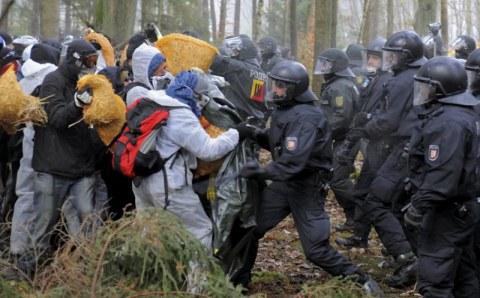
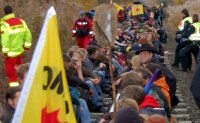
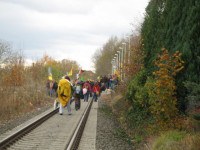
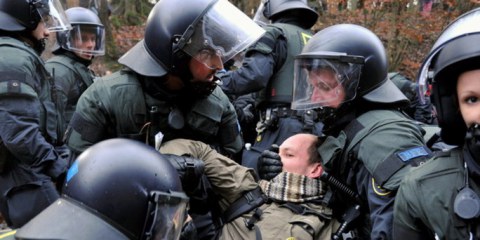
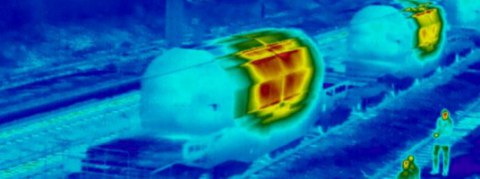
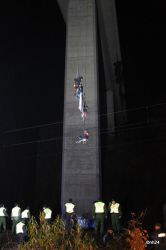
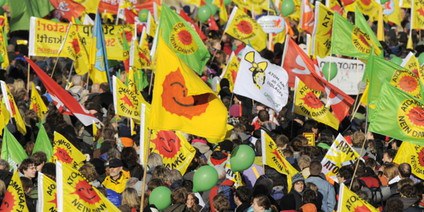

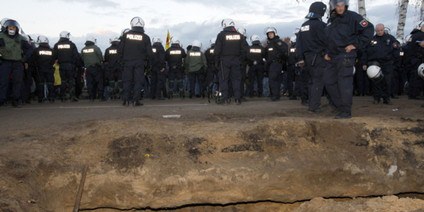
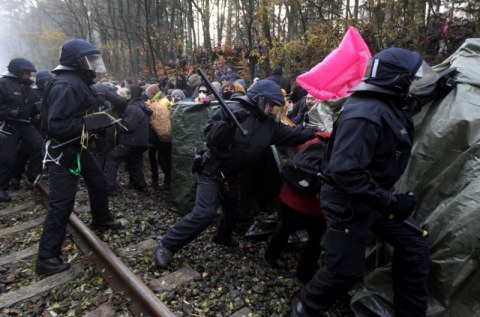
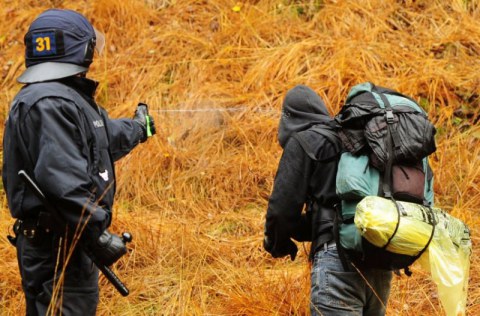

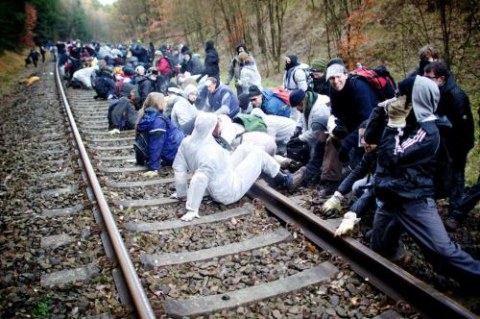
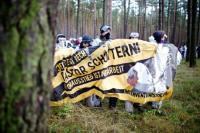



Comments
"Das gewalttätigste Polizeivorgehen im Wendland in zehn Jahren"
Gewalttätiger Atomstaat
Fazit des Polizeieinsatzes vom Ermittlungsausschuss Wendland
„In der Summe einer der brutalsten Polizeieinsätze anlässlich eines Castor-Transportes ins Wendland, auf jeden Fall das gewalttätigste Vorgehen der uniformierten Staatsmacht im Wendland in den letzten zehn Jahren“, fasst der Ermittlungsausschuss Wendland seine Eindrücke vom Protestgeschehen im Wendland vom 6. bis zum 9. November zusammen. Die Größe und Vielfalt der Proteste gegen den Castortransport in den letzten Tagen haben die Ablehnung der herrschenden Atompolitik in eindrucksvoller Weise verdeutlicht.
Die polizeilichen Einsatzstrategie ging mit Einschränkungen des Versammlungsrechtes durch Ingewahrsamnahmen, Platzverweise und umfangreichen Personalienkontrollen einher, die durch systematische polizeiliche Gewaltexzesse am Sonntag in der Göhrde ergänzt wurden. Die polizeiliche Durchsetzung des Transportes kann die mangelnde politische Legitimität der Atompolitik des Castortransportes nicht ersetzen.
In der Zeit vom 6. bis zum 9. November wurden mindestens 49 Personen von der Polizei in stationären Gewahrsam genommen. Nach den vorläufigen Erkenntnissen des EA Wendland wurden 25 Personen in die Gefangenensammelstelle (Gesa) Lüchow verbracht, 24 Personen in der Gesa Lüneburg festgehalten und ca. 1300 AktivistInnen in einem von der Polizei als mobile Gesa bezeichneten Kessel unter freiem Himmel festgehalten.
Über die Zahl und den Umfang sonstiger repressiver Maßnahmen wie Durchsuchungen, Beschlagnahmungen von Material und Grundstücken, Betretungs- und Durchgangsverboten, gewalttätige Übergriffe gegen Einzelne, Personalienfeststellungen auf dem Weg zu Mahnwachen, Platzverweisen für einzelne Orte oder weite Teile des Landkreises Lüchow-Dannenberg liegen nur fragmentarische Daten vor.
Am 8.11. wurden ohne Rechtsgrundlage Hofdurchsuchungen in Grippel, Zadrau und Langendorf durchgeführt, obwohl sie offensichtlich länger geplant waren. Die Bewegungsfreiheit von RechtsanwältInnen in der Nacht vom 8. auf den 9.11. entlang der Straßentransportstrecke war phasenweise durch polizeiliche Maßnahmen stark behindert.
In der Nacht vom 8. auf den 9. November hinderte die Polizei AnwohnerInnen in Laase, Grippel und Quickborn daran, ihre Häuser zu verlassen.
Scharfe Kritik übt der EA Wendland an den Zuständen im Kessel unter freiem Himmel in der Nacht vom 7. auf den 8. November am Ortsausgang von Harlingen. Bei der Errichtung dieses ‚Gefangenenlagers‘ wurden Gegenstände der benachbarten Mahnwache zerstört. Unklar ist die Rechtmäßigkeit einer solchen Maßnahme, die an jedem richterlichen Beschluss vorbei von der Polizei geplant und umgesetzt wurde.
Die richterliche Bereitschaft des zuständigen Amtsgerichtes, die für die Überprüfung der Fortdauer von Ingewahrsamnahmen zuständig ist, wurde erst vom anwaltlichen Notdienst über die Existenz dieses freiheitsentziehenden Kessels in Kenntnis gesetzt. Die Polizei verhinderte stundenlang die Möglichkeit der richterlichen Überprüfung der von ihr durchgeführten Maßnahmen gegenüber etwa 1300 DemonstantInnen in Harlingen.
So waren viele Hundert Personen gezwungen, bei Temperaturen unter dem Gefrierpunkt mehrere Stunden in der Kälte in Gefangenschaft zu verbringen. Zusätzlich wurden sie dabei unangekündigt und fortdauernd durch die Polizei fotografiert. Erst nach Intervention von Seelsorgern und RechtsanwältInnen konnte eine minimale Versorgung mit warmen Nahrungsmitteln durch die Volxküchen des Castor-Widerstandes ermöglicht werden. Durch die Polizei war eine Versorgung mit Lebensmitteln auch bei Freiheitsentziehungen von mehr als vier Stunden unter diesen Bedingungen weder vorgesehen noch ermöglicht.
‚Dies erinnert fatal an die rechtswidrigen Zustände im Laaser Kessel anlässlich des Castor-Transportes 2003‘, erinnerte eine Sprecherin des Ermittlungsauschusses an die gerichtlich festgestellte Rechtswidrigkeit des damaligen polizeilichen Vorgehens in Laase.
Der erschreckendste Angriff auf die Grundrechte der DemonstrantInnen ist jedoch die brutale Gewaltförmigkeit des polizeilichen Vorgehens gegen DemonstrantInnen, JournalistInnen und DemonstrationsbeobachterInnen in der Göhrde am Sonntag. Dabei hatten Hunderte PolizistInnen mit Schlagstöcken auf DemonstrantInnen eingeprügelt und großflächig und massenhaft Reizgas und Pfefferspray eingesetzt. Dabei wurden über 1000 Personen verletzt.
Das Ziel dieses regional bislang beispiellosen Polizeieinsatzes ist nicht die Auflösung einer Versammlung oder die Verhinderung einer Gleisbesetzung
gewesen, sondern ganz offensichtlich die massenhafte Verletzung und Einschüchterung von Aktivistinnen und Aktivisten. Augenzeugen berichten übereinstimmend, dass die Polizei ohne Vorwarnung und ohne vorigen Anlass vorgegangen sei. Sie trägt damit die alleinige Verantwortung für die späteren kleineren Auseinandersetzungen mit DemonstrationsteilnehmerInnen, bei denen auch vereinzelt Einsatzkräfte leicht verletzt wurden.
Abseits der Scheinwerfer und der Presse übten PolizistInnen gehäuft schmerzhafte Griffe und Schläge gegen SitzblockiererInnen in Harlingen aus. Besonders der Abtransport von den Gleisen zum Kessel erfolgte nicht selten unter der Androhung der Zufügung von Schmerzen, wenn BlockiererInnen nicht mitgehen, sondern auf dem Wegtragen bestehen wollten.
Auch Polizei aus Frankreich und Kroatien war vor Ort. In mindestens einem Fall haben französische CRS-Kräfte ihre Beobachtungsrolle verlassen. Den EA erreichten am 8.11. Schilderungen von Übergriffen durch Polizisten in CRS-Uniform nahe Leitstade. Ebenfalls kam während des Castoreinsatzes eine vermutlich polizeiliche Überwachungsdrohne probeweise zum Einsatz.
Trotz der ruhigen Räumung in der letzten Nacht vor dem Zwischenlager stellt der EA Wendland in der Gesamtschau fest, dass der Castortransport mit einer massiven Verletzung grundlegender rechtsstaatlicher Gebote einhergeht. Diese systematische Aushebelung der Grundrechte für die Durchsetzung der Interessen der Atomwirtschaft bezeichnen wir als Atomstaat.
Der Ermittlungsausschuss Wendland wird alle Betroffenen der polizeilichen und staatsanwaltschaftlichen Repression unterstützen, wenn diese das wünschen. Wie immer hat sich die Staatsmacht Einzelne herausgegriffen, um sie einzuschüchtern und stellvertretend für eine ganze Bewegung zu bestrafen. ‚Gemeint sind alle, und gemeinsam kann dieser Einschüchterung wirksam begegnet werden‘, stellt der EA Wendland fest.
ea-gorleben@nadir.org